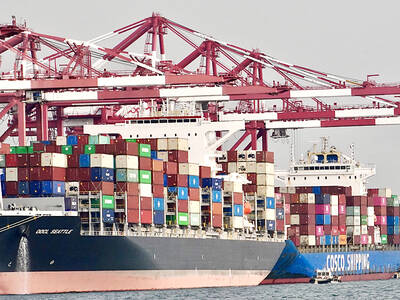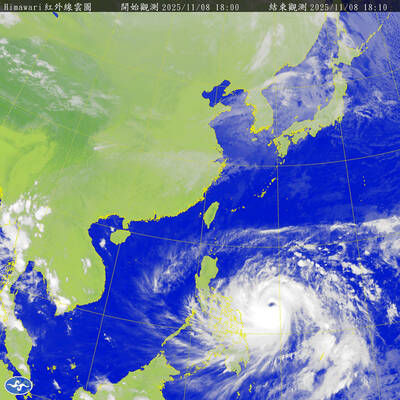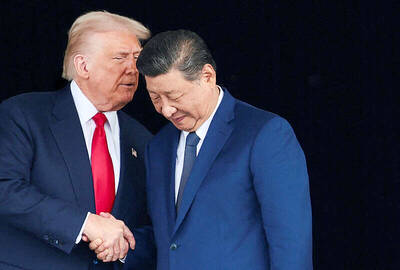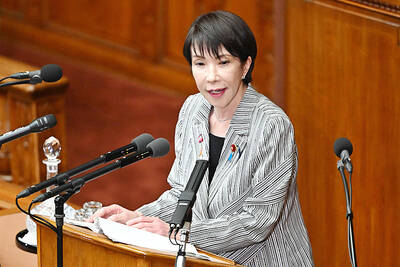The Ministry of Science and Technology and the Ministry of Education yesterday announced that it would slash NT$54 million (US$1.78 million) from subsidies earmarked for National Taiwan University this year after several academics were involved in the scandal surrounding allegedly fraudulent papers published by National Taiwan University professor Kuo Min-liang’s (郭明良) research team.
The ministries released the results of their investigations into the scandal that erupted in November last year after users of online academic forum PubPeer found out that several papers Kuo’s team submitted to international science journals between 2006 and last year contained possibly falsified findings.
The ministries reviewed 18 papers written by Kuo’s team, of which 11 were found to be in breach of academic ethics.

Photo: Liao Chen-huei, Taipei Times
The subsidy cut was proposed because the university had failed to curb academic misconduct, raising doubts among the public and tarnishing the nation’s academic reputation, Department of Higher Education Director Nicole Lee (李彥儀) told a news conference in Taipei.
The punishment is the most severe that the education ministry has ever handed an institution over breaches of academic ethics, she said.
A total of 13 academics implicated in the falsified research are to be punished.
Kuo, who served as the corresponding author and supervised research for all 18 papers, is to be barred from applying for science ministry research grants for 10 years for breaches of academic integrity, including duplicating and forging data presented in eight papers, and malfeasance in supervising the research.
The two ministries also ordered a recall of NT$4.05 million in research grants and prize money handed out to four academics.
Kuo, former dean of the university’s College of Life Science, is to return NT$1.54 million in research grants the science ministry gave him between 2005 and last year, in addition to NT$600,000 in cash awards he received from the education ministry for winning academic awards.
National Taiwan University associate professor of dentistry Chang Cheng-chi (張正琪), Kuo’s former doctoral student, falsified images, numbers and findings in four papers, including a 2013 paper published in Cell Death & Differentiation that contains falsified images.
As the 2013 paper was the key publication that earned Chang her title of associate professor, the university should disqualify her as a member of its teaching staff and deny her promotions for five to 10 years, Lee said.
The university might dismiss Chang either temporarily or permanent in accordance with the Teachers’ Act (教師法), Lee said.
National Taiwan University Hospital vice superintendent Lin Ming-tsan (林明燦) falsified images, numbers and research findings in all four of the group’s papers in which he was involved and in one paper also plagiarized others’ research, the investigation found.
He is to return NT$810,000 that the science ministry awarded to his projects between 2008 and last year, and could face dismissal from the university and demerits from the hospital, Lee said.
National Health Research Institutes associate researcher Su Jen-liang (蘇振良), who forged images in three papers published in international scientific journals between 2006 and 2007, is to turn in NT$345,000 in research grants he received between 2007 and last year, the science ministry said.
Su, whose doctoral dissertation in 2003 focused on research similar to that shown in two problematic papers he submitted in 2006, would have his doctorate revoked if his dissertation is also found to contain falsified information after further inquiry, Lee said.
Three master’s candidates — whose names were absent from the university’s independent investigation that concluded last month — provided falsified images and numbers for three problematic papers and are to have their diplomas revoked if the university confirms their offenses, Lee said.
The probe did not find any breaches of academic integrity by National Taiwan University president Yang Pan-chyr (楊泮池), who coauthored four problematic papers with Kuo and provided cell material samples for one of the problematic papers.
Ministry of Education Senior Specialist Wang Shu-chuang (王淑娟) said that Yang’s role in a 2006 paper published in the journal Cancer Cell was to provide cell material samples for use by Su in his research.
The paper underwent two “major” corrections in 2006 and 2008, and although it was unlikely that Yang could have any prior knowledge of the falsified portions in the paper, he should have been alarmed after the first instance and prevented it from being corrected the second time.
Considering this and the fact that his name appeared in the papers in titles ranging from the second author to the 12th author, damaging the school’s reputation, Yang should engage in introspection, Wang said.
The university had informed the ministry that Yang, whose term expires in June, would refrain from seeking another term, Wang said.

Taiwan’s exports soared to an all-time high of US$61.8 billion last month, surging 49.7 percent from a year earlier, as the global frenzy for artificial intelligence (AI) applications and new consumer electronics powered shipments of high-tech goods, the Ministry of Finance said yesterday. It was the first time exports had exceeded the US$60 billion mark, fueled by the global boom in AI development that has significantly boosted Taiwanese companies across the international supply chain, Department of Statistics Director-General Beatrice Tsai (蔡美娜) told a media briefing. “There is a consensus among major AI players that the upcycle is still in its early stage,”

The Central Weather Administration (CWA) yesterday said it expected to issue a sea warning for Typhoon Fung-Wong tomorrow, which it said would possibly make landfall near central Taiwan. As of 2am yesterday, Fung-Wong was about 1,760km southeast of Oluanpi (鵝鑾鼻), Taiwan’s southernmost point, moving west-northwest at 26kph. It is forecast to reach Luzon in the northern Philippines by tomorrow, the CWA said. After entering the South China Sea, Typhoon Fung-Wong is likely to turn northward toward Taiwan, CWA forecaster Chang Chun-yao (張峻堯) said, adding that it would likely make landfall near central Taiwan. The CWA expects to issue a land

‘SECRETS’: While saying China would not attack during his presidency, Donald Trump declined to say how Washington would respond if Beijing were to take military action US President Donald Trump said that China would not take military action against Taiwan while he is president, as the Chinese leaders “know the consequences.” Trump made the statement during an interview on CBS’ 60 Minutes program that aired on Sunday, a few days after his meeting with Chinese President Xi Jinping (習近平) in South Korea. “He [Xi] has openly said, and his people have openly said at meetings, ‘we would never do anything while President Trump is president,’ because they know the consequences,” Trump said in the interview. However, he repeatedly declined to say exactly how Washington would respond in

Japanese Prime Minister Sanae Takaichi said yesterday that China using armed force against Taiwan could constitute a "survival-threatening situation" for Japan, allowing the country to mobilize the Japanese armed forces under its security laws. Takaichi made the remarks during a parliamentary session yesterday while responding to a question about whether a "Taiwan contingency" involving a Chinese naval blockade would qualify as a "survival-threatening situation" for Japan, according to a report by Japan’s Asahi Shimbun. "If warships are used and other armed actions are involved, I believe this could constitute a survival- threatening